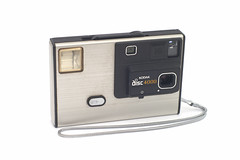Disc film

|
| Kodak Disc 4000 a typical disc camera |
Disc film was a format introduced by Kodak, along with the cameras in June 1982 (in the US) and September 1982 (in the UK). The intention was to develop the Instamatic idea, of foolproof loading and simple operation, into cameras which would work in all lighting conditions. Developments in emulsion technology were allowing reasonable quality from very small negatives.
Format
Fairly thick film was cut into 15 8×10.5mm rectangles, and arranged into a circle, in a similar manner to Viewmaster disks. The disc was mounted in a light-proof cassette which could simply be dropped in to the camera. The camera would take a photo, and then rotate the disk 24° for the next shot. The discs had a magnetic strip included, to store information about print settings - allowing duplicate reprints to be made later.
The discs were only available for colour prints - no other types, such as slide film, were made. Konica, Fuji and 3M also made disc film - which was also sold branded by other companies.
Cameras
Kodak developed special aspherical lenses for the cameras and printing. The flat, roll-less arrangement of the film, meant that disc cameras could be very thin, and the negative size allowed very short focal-length lenses (typically 12.5mm), and so lenses did not bulge out far. Most disk cameras were small & thin, with automatic exposure and often automatic flash. However the complex mechanism in a small space made manufacture difficult, and the film expensive. Once Kodak had established the format, many other companies also made Disc film cameras. Still more - such as the Boots chain in the UK - sold their own brand Disc cameras made for them by others.
Disc Camera Brands
Many of these are retailers of cameras made OEM by others.
Achiever, Alfon, Ansco, Birex, Black, Boots, Bushnell, Concord, Continental, Dejur, Dixons, Fuji, Halina, Hanimex, Image, Imperial, Keystone, Kinon, Kodak, Konica, Minolta, Nova, Osram, Premier, Prolux, Regula, Revue, Rokinon, Ronrico Rum, Rosley, Sears, Starblitz, Sylvania, Viceroy, Voigtländer, W.H.Smith, Wotan.
Results and Demise
The quality of pictures was not good, due to the size of the negatives and the tendency of photo labs to print them using optics designed for larger formats rather than use Kodak's specially-designed system.
The format ultimately failed due to the poor picture quality, the relative expense of the cameras compared to other formats, and reliability problems. Newer 35mm cameras - providing much better images - had become more popular, and disc cameras went out of production in 1988. Most manufacturers stopped making film shortly afterwards - although Kodak carried on with film until 1999.
Reference: Coe, Brian, Kodak Cameras - the First Hundred Years, pp.261-265, Hove Foto Books, Hove, UK, 1988.
Links
- The Disc Camera Info page has some history of the cameras, and an alphabetical list of manufacturers and their models.
- Disc Camera Gallery
- photos (text in German)
- Definition at PhotoNotes.org